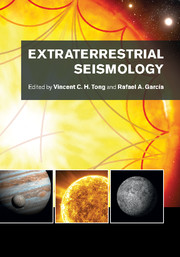Book contents
- Frontmatter
- Contents
- List of contributors
- Preface
- Acknowledgements
- List of abbreviations
- Planetary seismology: High risk, high return
- A bright outlook for helio- and asteroseismology
- Part I Observation and space missions
- Part II Data and physical parameters
- Part III Modeling approaches
- Part IV Discoveries of physical structures and processes
- Part V Interdisciplinary research involving planetary and astrophysical sciences
- Part VI Interdisciplinary research involving terrestrial seismology
- References
- Index
A bright outlook for helio- and asteroseismology
Published online by Cambridge University Press: 05 July 2015
- Frontmatter
- Contents
- List of contributors
- Preface
- Acknowledgements
- List of abbreviations
- Planetary seismology: High risk, high return
- A bright outlook for helio- and asteroseismology
- Part I Observation and space missions
- Part II Data and physical parameters
- Part III Modeling approaches
- Part IV Discoveries of physical structures and processes
- Part V Interdisciplinary research involving planetary and astrophysical sciences
- Part VI Interdisciplinary research involving terrestrial seismology
- References
- Index
Summary
As documented in the following, very substantial results have already been obtained from helio- and asteroseismology, based on huge observational projects, such as the GONG project, the helioseismic instruments on the Solar and Heliospheric Observatory (SOHO) and Solar Dynamics Observatory (SDO) satellites, and asteroseismology with the CoRoT and Kepler missions. But this is just the beginning. New asteroseismic projects are on the way, and there are also plans for new developments in observational helioseismology, including multi-wavelength observations (Hill et al., 2013). For local helioseismology a potential breakthrough will come from ESA's Solar Orbiter mission (Gandorfer et al., 2011), which will for the first time allow detailed investigations of the regions near the solar poles.
However, there is much to be done with the existing data, and much to be done further to develop the analysis techniques. The helioseismic data have been far from fully exploited, with the inverse analyses being typically based just on a small fraction of the available observations. In particular, the high-resolution observations from the Helioseismic and Magnetic Imager (HMI) instrument on SDO may provide reliable frequency data on high- degree modes, which would allow more detailed investigations of the thermodynamics of the region of helium ionization (e.g., Rabello-Soares et al., 2000). Also, the base of the solar convective envelope certainly deserves further investigation, including an updated search for possible latitude variations (Monteiro and Thompson, 1998) and a follow-up to the hint of solar-cycle variations found by Baldner and Basu (2008). The helioseismic data on frequency splittings have been extensively used to study variations of solar internal rotation during the solar cycle (for a recent example, see Howe et al., 2013). However, further work is certainly required on constraining the rotation of the solar core, where improvements in the inversion techniques may allow a better localization and balance between resolution and error.
- Type
- Chapter
- Information
- Extraterrestrial Seismology , pp. 5 - 8Publisher: Cambridge University PressPrint publication year: 2015



